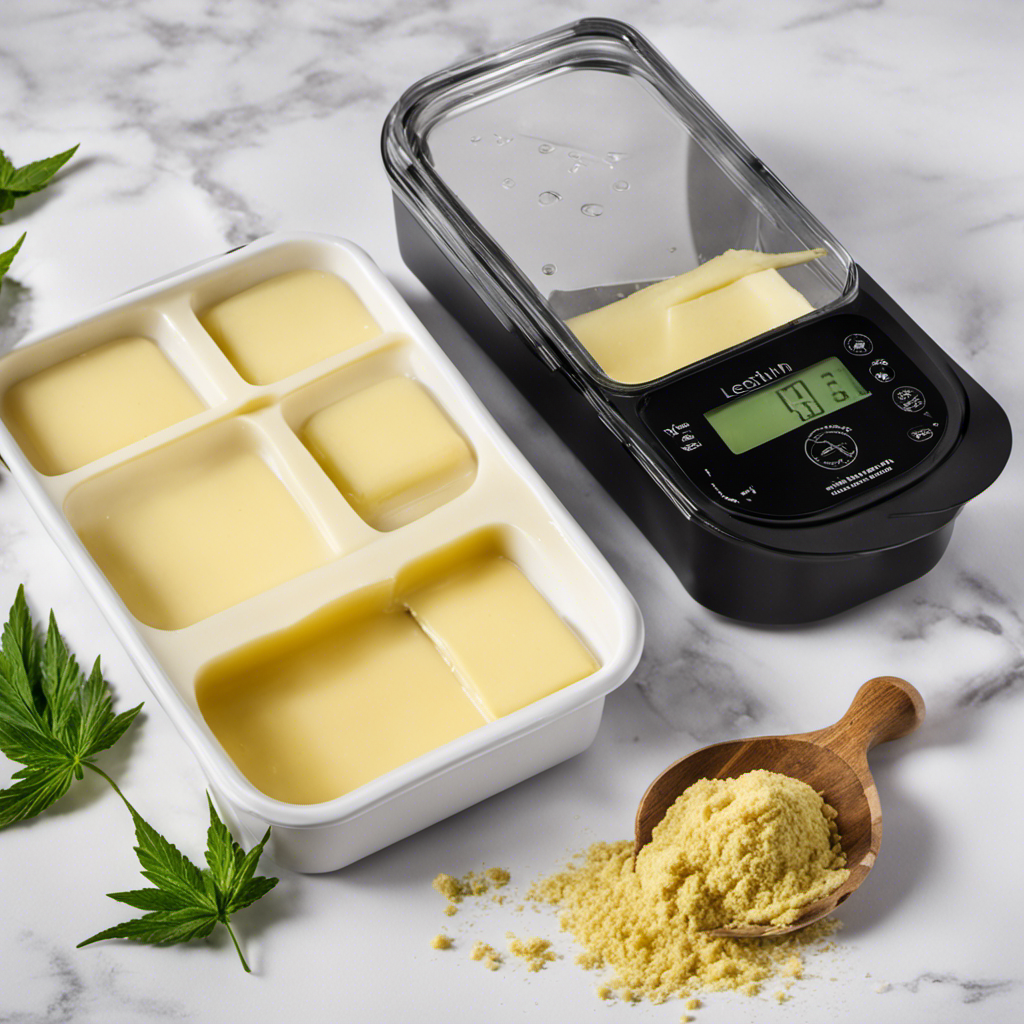Are you curious about what makes salted butter so deliciously flavorful? Interested in finding out the exact amount of salt present in a stick?
Get ready to uncover the truth in this informative article. We’ll explore the basics of salted butter, the varying salt content among different brands, and the factors that influence it.
You’ll also learn how to calculate the exact amount of salt in a stick of your favorite butter. Plus, we’ll discuss health considerations and alternatives for those watching their sodium intake.
Let’s dive in and discover the hidden salt in your beloved butter!
Key Takeaways
- Different brands of salted butter have varying salt content, such as Brand A with 1.5g of salt per 100g, Brand B with 2.0g of salt per 100g, and Brand C with 1.8g of salt per 100g.
- Excessive sodium intake from salted butter can increase the risk of high blood pressure, heart disease, and stroke.
- Proper sodium intake is important for maintaining fluid balance, nerve function, and muscle contraction, as well as supporting nutrient absorption and healthy blood pressure levels.
- Individuals on low-sodium diets can opt for alternatives to salted butter such as unsalted butter, olive oil, avocado, Greek yogurt, nut butters, margarine without added salt, plant-based spreads, homemade spreads using herbs and spices, and reduced-sodium cream cheese or hummus.
Understanding the Basics of Salted Butter
Salted butter is a popular ingredient in many recipes. It adds a rich and savory flavor to both sweet and savory dishes. One of the benefits of using salted butter is that it enhances the taste of your food. The salt in the butter helps to bring out the natural flavors of the ingredients, making your dish more delicious.
Additionally, salted butter can be used in a variety of recipes, such as cookies, cakes, and even sautéed vegetables. Its versatility makes it a staple in many kitchens.
Now that you understand the basics of salted butter and its benefits, let’s explore the salt content of different brands of salted butter.
The Salt Content of Different Brands of Salted Butter
In this discussion, we will explore the variations in salted butter, comparing the levels of salt in different brands and the implications it has on your health.
When it comes to salted butter, not all brands are created equal. Some may have higher or lower salt content, which can affect the taste and overall quality of your dishes.
It’s important to be informed about the salt levels in different brands to make healthier choices for your diet.
Salted Butter Variations
There’s a wide variety of butter options available, including different variations of salted butter. When it comes to salted butter, not only can you use it as a spread, but it also adds a delicious savory flavor to various recipes.
Here are some ideas for using salted butter in your cooking:
-
Salted butter cookies: The saltiness of the butter enhances the sweetness of the cookies, creating a perfect balance of flavors.
-
Salted butter caramel sauce: Adding salted butter to caramel sauce brings a delightful savory note that complements the rich sweetness.
-
Salted butter popcorn: Melted salted butter drizzled over freshly popped popcorn creates a mouthwatering snack.
-
Salted butter roasted vegetables: Tossing vegetables in melted salted butter before roasting adds an extra layer of flavor and richness.
-
Salted butter pasta: Mixing cooked pasta with melted salted butter creates a simple yet delicious base for various pasta dishes.
If you prefer to avoid salted butter, you can always substitute it with unsalted butter and add salt to taste.
Comparing Salt Levels
If you’re comparing the salt levels, it’s important to consider the different variations of butter available. Salted butter comes in various brands and each may have a different amount of salt added during the manufacturing process. To help you make an informed choice, here’s a comparison of salt levels in some popular salted butter variations:
| Brand | Salt Level (per 100g) |
|---|---|
| Brand A | 1.5g |
| Brand B | 2.0g |
| Brand C | 1.8g |
| Brand D | 1.2g |
| Brand E | 1.7g |
As you can see from the table, the salt levels vary between brands. If you’re watching your sodium intake or prefer a less salty taste, you might opt for Brand D with the lowest salt level. However, if you enjoy a bolder flavor, Brand B might be the right choice for you. Remember to check the packaging or consult the manufacturer’s website for the most accurate and up-to-date information on salt levels in salted butter variations.
Health Implications of Salt
To maintain a healthy diet, you should be mindful of the amount of sodium you consume. Excessive sodium intake can have negative health implications, such as increasing the risk of high blood pressure, heart disease, and stroke. On the other hand, consuming an appropriate amount of sodium can provide several health benefits.
The recommended daily intake of sodium for adults is no more than 2,300 milligrams, or about a teaspoon of salt. Here are five reasons why you should be mindful of your sodium intake:
- Helps maintain proper fluid balance in the body
- Assists in nerve function and muscle contraction
- Supports the absorption of certain nutrients
- Aids in maintaining healthy blood pressure levels
- Reduces the risk of developing chronic diseases
Factors That Affect the Salt Content in Salted Butter
You can easily control the salt content in salted butter by adjusting the amount of salt you add during the preparation process. There are several factors that can affect the taste of salted butter, which in turn can impact the outcome of your baking. These factors include the type of salt used, the ratio of salt to butter, and the quality of the butter itself.
| Factors Affecting Taste | Impact on Baking |
|---|---|
| Type of salt used | Can affect the overall flavor of the butter and the baked goods. Different types of salt, such as sea salt or kosher salt, can have varying levels of saltiness and other flavor profiles. |
| Ratio of salt to butter | A higher ratio of salt to butter will result in a saltier taste, while a lower ratio will result in a milder flavor. It is important to find the right balance to enhance the taste of your baked goods. |
| Quality of the butter | The quality of the butter used can also impact the taste. Higher quality butter tends to have a richer, more pronounced flavor, which can enhance the overall taste of the salted butter and the baked goods. |
How to Calculate the Amount of Salt in a Stick of Salted Butter
Calculating the amount of salt in a stick of salted butter can be done by considering the ratio of salt to butter used in the preparation process. To determine the salt content, you need to know the weight of the stick of butter and the percentage of salt added during production. Here’s how to calculate it:
- Determine the weight of the stick of salted butter.
- Find the percentage of salt added in the butter.
- Convert the percentage to a decimal by dividing it by 100.
- Multiply the weight of the butter by the decimal value of the salt percentage.
- This will give you the amount of salt in the stick of salted butter.
It’s important to note that the impact of salt on butter quality can vary. Salt enhances the flavor and helps preserve the butter. However, too much salt can overpower the taste and negatively affect the texture. Finding the right balance is crucial for a delicious and high-quality salted butter.
Health Considerations and Recommendations for Salted Butter Consumption
When it comes to your sodium intake, it’s important to follow the guidelines set forth by health organizations.
Excess salt can have a negative impact on your health, increasing your risk of high blood pressure, heart disease, and stroke.
Understanding the health risks associated with consuming too much salt can help you make informed choices about your diet and overall well-being.
Sodium Intake Guidelines
The sodium intake guidelines recommend limiting the amount of salt consumed daily. It is important to be mindful of your sodium intake as excessive salt consumption can have negative effects on your health.
Here are some key points to consider:
- High sodium intake can increase blood pressure and put strain on your heart.
- Consuming too much salt can lead to fluid retention and bloating.
- A high-sodium diet is linked to an increased risk of cardiovascular diseases.
- Excessive sodium intake can also contribute to kidney problems.
- It is advisable to explore alternatives to salted butter, such as unsalted butter or low-sodium spreads, to reduce your sodium intake.
Health Risks of Excess Salt
Excessive consumption of salt can lead to negative health effects. These include increased blood pressure and a higher risk of cardiovascular diseases. When you consume too much salt, it can cause your body to retain water. This leads to higher blood volume and increased pressure on your blood vessels. As a result, this can strain your heart and increase your risk of developing hypertension and other cardiovascular conditions.
Studies have shown that reducing sodium intake can significantly lower blood pressure levels. This, in turn, reduces the risk of heart disease and stroke. The impact of excessive sodium intake on blood pressure is well-documented. Therefore, it is important to monitor and reduce your salt consumption to maintain a healthy cardiovascular system.
Alternatives to Salted Butter for Those on a Low-Sodium Diet
There are alternatives to salted butter for those on a low-sodium diet. If you’re looking to reduce your intake of sodium, here are some options to consider:
-
Unsalted butter: This is a straightforward alternative to salted butter. It contains no added salt and can be used in the same way in your low sodium recipes.
-
Olive oil: Olive oil is a heart-healthy option that can be used as a substitute for butter in many recipes. It adds a rich flavor and can be a great addition to your low sodium dishes.
-
Avocado: Mashed avocado can be a creamy replacement for butter in baking or spreading on toast. It’s also a good source of healthy fats and nutrients.
-
Greek yogurt: Greek yogurt can be used in place of butter in certain recipes, like muffins or cakes. It adds moisture and a tangy flavor.
-
Nut butters: Peanut butter, almond butter, or cashew butter can be a delicious and nutritious substitute for butter in many recipes. They add a creamy texture and nutty flavor.
Conclusion
Congratulations! You’ve journeyed through the world of salted butter, unraveling its mysteries and discovering its secrets.
Just like a humble stick of butter, this article has brought flavor and richness to your understanding.
Remember, the salt content may vary among different brands, but with the right knowledge, you can calculate it accurately.
As you savor the taste, keep in mind your health and explore low-sodium alternatives.
So go forth, armed with knowledge, and let the buttery adventure continue!










